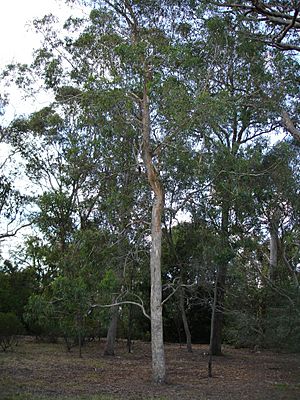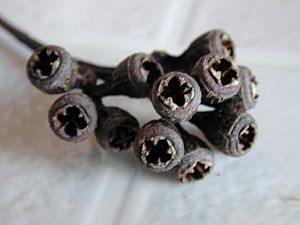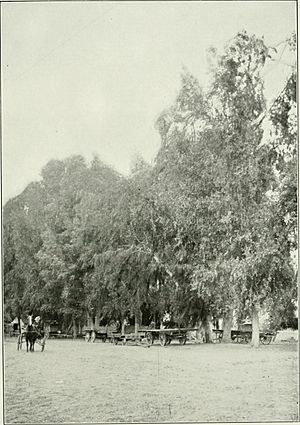Flooded gum facts for kids
Quick facts for kids Flooded gum, moitch |
|
|---|---|
 |
|
| Eucalyptus rudis in Maranoa Gardens | |
| Scientific classification | |
| Genus: |
Eucalyptus
|
| Species: |
rudis
|
 |
|
| E. rudis, field distribution | |
| Synonyms | |
|
Eucalyptus brachypoda Turcz. |
|
The Eucalyptus rudis, also known as flooded gum or moitch, is a type of tree found only in coastal areas near Perth, Western Australia. The Noongar people, who are the traditional owners of this land, call the tree colaille, gooloorto, koolert, and moitch. This tree has rough, stringy bark on its trunk and big branches. Its upper branches have smooth, grey bark. It has long, curved leaves, white flowers, and bell-shaped or cup-shaped fruit.
Contents
What the Flooded Gum Looks Like
The Flooded Gum is a tree that usually grows to be about 5 to 20 meters (16 to 65 feet) tall. It has a special woody swelling at its base called a lignotuber. This helps the tree regrow if it's damaged, like by fire.
Its trunk is often short, and it has a wide, spreading top. The bark on its trunk and larger branches is rough and can be dark or light grey. Higher up, the bark is smooth and greyish.
Young Flooded Gum plants have stems that are square-shaped. Their leaves are dull grey-green and egg-shaped or round, about 2.5 to 7 centimeters (1 to 2.7 inches) long. As the tree gets older, its leaves change. Adult leaves grow in an alternating pattern and are shaped like a spear or are slightly curved. They are about 7 to 18 centimeters (2.7 to 7 inches) long.
The tree's flower buds grow in groups of seven, nine, or eleven. They are oval to diamond-shaped. The Flooded Gum mostly blooms from July to November, and its flowers are white. After flowering, it produces woody, bell-shaped or cup-shaped fruit, which are its seed pods. These pods are about 4 to 7 millimeters (0.15 to 0.27 inches) long.
Sometimes, in areas north of Perth, the Flooded Gum can look very similar to another tree called Eucalyptus camaldulensis. This is because they can mix together.
How the Flooded Gum Got Its Name
Scientists have a special way of naming and classifying plants, which is called taxonomy. The Eucalyptus rudis was first officially described in 1837. This happened when a scientist named Stephan Endlicher wrote about it. He used samples collected by Charles von Hügel near the Swan River Colony in Western Australia.
Later, in 1993, two other scientists, Ian Brooker and Stephen Hopper, found that there are actually two slightly different types, or subspecies, of Flooded Gum:
- Eucalyptus rudis subsp. cratyantha: This type has larger buds (up to 15 mm long) and fruit (up to 14 mm wide).
- Eucalyptus rudis subsp. rudis: This type has smaller buds (up to 12 mm long) and fruit (up to 9 mm wide).
Where the Flooded Gum Lives
The Flooded Gum is found across a wide area in Western Australia. It grows from the Eneabba district in the north, southwards into the Darling Scarp and the high rainfall areas of the south-west.
You can often find these trees growing near rivers, in swampy areas, or sometimes on granite rocks. The subspecies cratyantha is found only in the southern part of this range, from Mandurah and Pinjarra down to Cape Naturaliste.
Flooded Gums usually grow in open woodlands. They often share their home with other native trees like wandoo, Corymbia calophylla, and Eucalyptus marginata.
Ecology and Life Cycle
In spring, the Flooded Gum can be attacked by different kinds of insects. These include tiny insects that live inside the leaves (leaf miners), leaf blister sawflies, and lerps. Even with these attacks, the tree's top part (its crown) grows back strongly in late spring and through the summer.
Conservation Status
It's important to know if a plant species is safe or if it needs help to survive. This is called its conservation status.
In Western Australia, the main type of Flooded Gum, Eucalyptus rudis subsp. rudis, is considered "not threatened" by the government's Department of Parks and Wildlife. This means it's doing well.
However, the subspecies Eucalyptus rudis subsp. cratyantha is listed as "Priority Four". This means it is rare or nearly threatened, and scientists are keeping a close eye on it to make sure it stays safe.
How People Use the Flooded Gum
The Flooded Gum grows fairly quickly. This makes it useful for helping land that has been damaged by too much salt.
Natural groups of these trees are important for the honey industry. Bees collect pollen from the Flooded Gum, which helps them make a light amber-colored honey.
Scientists are also looking into using the Flooded Gum as a fast-growing source of plant material for bioenergy (energy from plants) and for making wood products in the South West region.
Historically, people have used the wood from Flooded Gums for firewood. The wood is hard and has a yellow to light reddish-brown color. It can also be used as a special type of timber.



